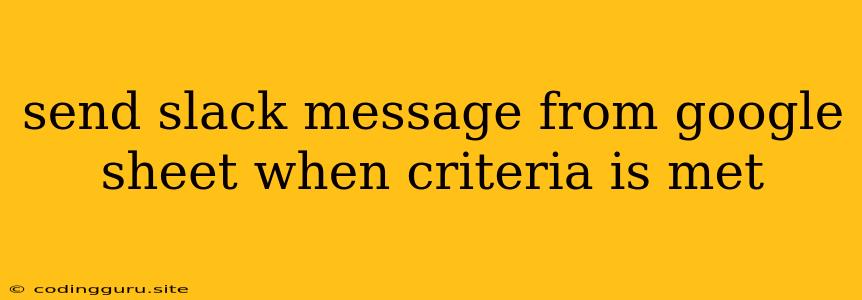Sending Slack Messages from Google Sheets: Automating Your Workflow
In the modern digital age, streamlining your workflow is key to maximizing efficiency and productivity. Integrating your favorite applications is an essential step in this process, and this article will guide you through the process of sending Slack messages directly from your Google Sheet, triggered by specific criteria. This powerful functionality lets you automate tasks, receive important updates, and collaborate seamlessly across teams.
Why Send Slack Messages from Google Sheets?
Imagine a scenario where your team needs to be notified whenever a specific project deadline is approaching. Instead of manually checking the spreadsheet and sending out a reminder, you can automate this process by setting up a trigger that automatically sends a message to your Slack channel. This saves time, reduces errors, and ensures everyone is kept in the loop.
Here are some other compelling reasons to leverage this integration:
- Real-time notifications: Receive immediate updates when changes occur within your spreadsheet, without having to constantly refresh the data.
- Collaboration enhancement: Share key updates with your team in Slack, fostering efficient communication and information sharing.
- Automated task assignments: Trigger messages to assign tasks to team members based on specific criteria in your sheet.
- Streamlined workflows: Create a seamless flow between your data analysis in Google Sheets and team communication in Slack.
How to Send Slack Messages from Google Sheets
The most common method for achieving this integration involves using a combination of Google Apps Script and a third-party service like Zapier. Here's a step-by-step guide to get you started:
1. Setting Up Your Google Apps Script:
- Open your Google Sheet: Navigate to the spreadsheet where you want to implement the automated Slack message.
- Open Script Editor: Click on "Tools" > "Script editor".
- Paste the Script: Paste the following code into the script editor:
function sendSlackMessage(message, channel) {
var url = "https://hooks.slack.com/services/";
var payload = {
"text": message,
"channel": channel
};
var options = {
"method": "post",
"contentType": "application/json",
"payload": JSON.stringify(payload)
};
UrlFetchApp.fetch(url, options);
}
- Replace placeholders: In the code, replace
<YOUR_SLACK_WEBHOOK_URL>with your actual Slack webhook URL. To obtain this, you'll need to create a Slack app and create an Incoming Webhook integration within your desired channel. - Configure the trigger: Click on "Edit" > "Current project's triggers" and set up a trigger based on your desired criteria. For example, you can trigger the function whenever a specific cell value changes or when a new row is added.
2. Using Zapier (or similar tools)
Zapier is a popular platform that allows you to connect various applications and automate workflows. It provides a user-friendly interface for creating integrations without requiring coding.
Here's a simplified guide to using Zapier for your Google Sheets to Slack integration:
- Create a Zap: Login to Zapier and create a new Zap.
- Choose your Trigger App: Select "Google Sheets" as your trigger app.
- Choose the Trigger Event: Choose the specific event that triggers the Zap, such as "New spreadsheet row" or "Updated spreadsheet row."
- Connect your Google Sheet: Authorize Zapier to access your Google Sheet and select the specific spreadsheet and worksheet.
- Choose your Action App: Select "Slack" as your action app.
- Choose the Action Event: Select "Send message" as the action event.
- Configure the Action: Enter the message you want to send to your Slack channel, choose the channel, and configure any additional options.
- Test and activate: Test the Zap to ensure it works correctly and activate it to enable automated messages.
Examples and Best Practices
Example 1: Project Deadline Reminders:
Let's say you have a spreadsheet tracking various project deadlines. You can set up a trigger to send a Slack message to the project team 2 days before the deadline.
Example 2: Sales Opportunity Updates:
When a new sales opportunity is added to your spreadsheet, you can trigger a message in Slack with the opportunity details, notifying the sales team.
Best Practices:
- Keep messages concise and informative: Focus on delivering key information in a clear and concise manner.
- Format your messages for readability: Use appropriate formatting like bold text, bullet points, or code blocks to enhance readability.
- Consider using templates: Create reusable templates for common message types to save time and ensure consistency.
- Test thoroughly: Always test your automation before activating it to avoid unintended consequences.
Conclusion
Sending Slack messages from Google Sheets offers a powerful way to streamline your workflows, enhance collaboration, and receive real-time updates. By combining the versatility of Google Sheets with the communication capabilities of Slack, you can automate tasks, share key information, and foster a more efficient and collaborative working environment.
Remember, whether you choose Google Apps Script or a platform like Zapier, the key is to understand your specific requirements and choose the method that best suits your needs. By exploring these options and incorporating best practices, you can unlock the full potential of this valuable integration and take your workflow to the next level.
